Since its introduction, many farmers have availed of the Tillage Capital Investment Scheme (TCIS) to help fund machinery and technology upgrades, including Graham Sixsmith from Kilmeague, Co Kildare. Two years ago, Graham updated his 4t mounted Bogballe spreader to a trailed Rauch Axent 100.1, 10t fertiliser spreader with GPS section control.
Why Rauch?
In 2007, Graham bought a 4t spreader mounted on a bogey axle. This spreader was later upgraded in 2013. The system was working successfully.
However, as the acreage being farmed and the distance being travelled began to grow, so too did the workload. The system meant that Graham and his father needed to travel up to 24 miles each way with two tractors on the spreader and fertiliser trailer. It was becoming time- and labour-intensive.
With the backing of a successful TCIS application at his disposal, Graham decided this was the opportunity to upgrade his system. He carefully studied all brands on the market, before narrowing it down to either a Rauch or Amazone machine.
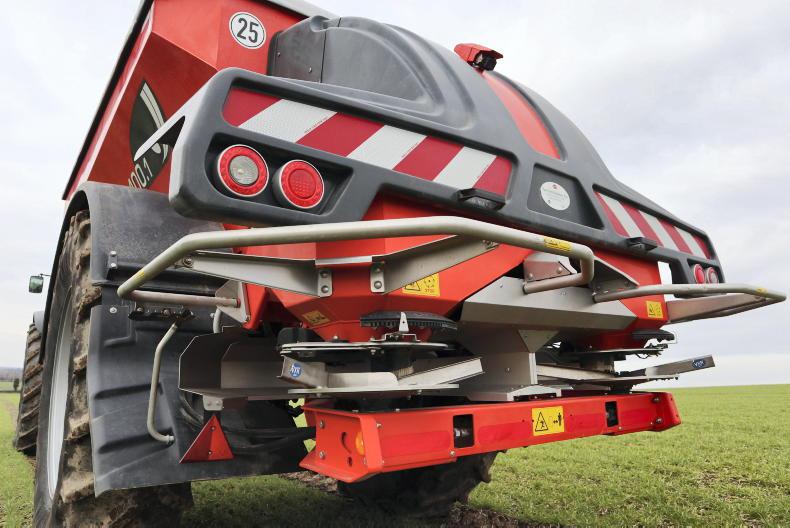
The Axent 100.1 shares the same rear-mounted fertiliser spreading unit as what’s on its mounted spreaders.
Graham explained: “I suppose the reason we didn’t opt for the Amazone machine was that it didn’t have its own on-board hydraulic system like the Rauch.
“Amazone also only offered an 8.5t model at the time, and it was the last of the older models. I also preferred the Rauch headland management system.”
Spreader mechanism
Rauch use the same rear-mounted fertiliser spreading unit on the bulk spreader featured as what’s on its mounted spreaders. The fertiliser is fed from the hopper via a hydraulic belt conveyor into a pre-chamber above the spreader discs.
The flow into each of the two pre-chambers is controlled independently via two doors. Beyond the door, a comb-type auger feeds the fertiliser along.
Two sensors each side determine the rate of fertiliser flow into the pre-chambers, based on the desired application rate set by the operator in the cab. All of the drives on the machine are hydraulic.
The Axent’s rear spreading unit uses Rauch’s own EMC (Electronic Massflow Control) technology. EMC is Rauch’s solution to measuring the flow rate of fertiliser.
The system is based on the principle that the drive torque of each disc is proportional to the flow of fertiliser.
In simple terms, this means the rate of fertiliser leaving the spreading vanes is measured through the torque in the gearbox. Therefore, weigh cells are not necessarily needed but the option is available.
EMC technology controls flow rate on each side of the machine individually.
While spreading, shutter position constantly changes on each side of the spreader independently to achieve the set flow rate, all of which can be monitored from the terminal in the cab. Rauch says the flow rate of the fertiliser is measured every two seconds.
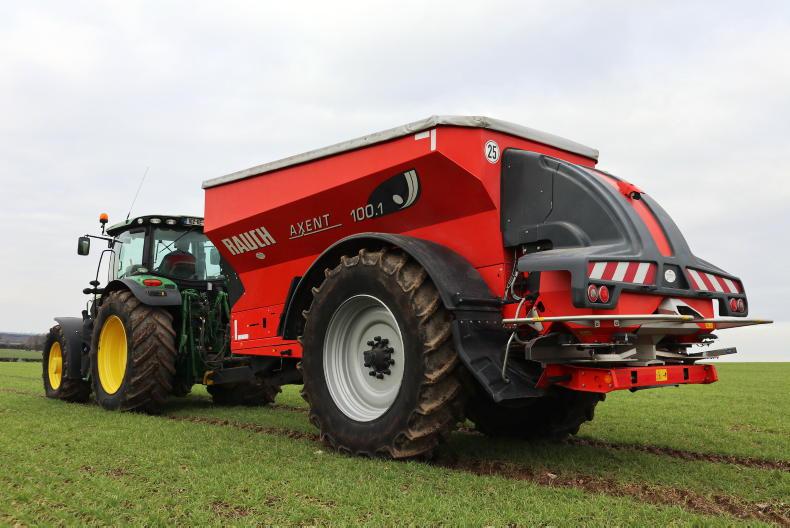
.
Graham opted for the additional weigh cells which allows him to keep an eye on the spreader’s load from the control terminal.
The machine uses its own independent hydraulic system. The PTO-driven axial piston pump provides the power to function the rubber belt drive, pre-dosing slides and the rear spreading unit.
The unit also has its own cooling system, with the viscous fan running as required.
Section control
Graham’s machine is equipped with the larger 12.1in CCI Isobus terminal. He noted that he doesn’t use the tractor’s control terminal as he likes to have one screen dedicated solely to the spreader and GPS function, rather than having to swipe through several pages on a small tractor screen.
The GPS receiver is independently mounted on the spreader, meaning any tractor on the farm can easily pull the spreader.
The spreader is fitted with full GPS section control. It has 30 sections at 1m intervals, which will each automatically switch off to prevent overlapping of fertiliser.
Using a GPS spreader wasn’t new for Graham, but using section control on a fertiliser spreader was.
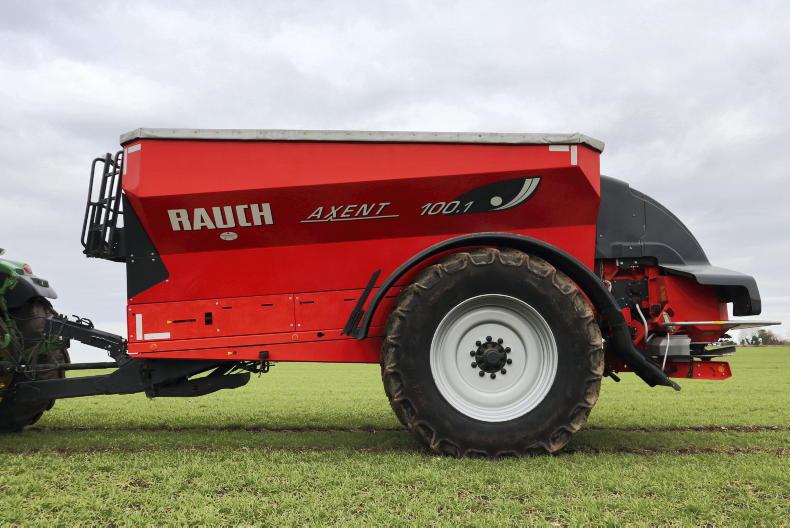
“When I go into each field, I know exactly how much fertiliser I want to apply. Since I moved to the new spreader that hasn’t changed, but the accuracy of placement probably has.
“With the section control, I know I’m definitely not wasting any fertiliser on the headlands or when I come to gearogs. I have had section control on my sprayer for a few years now.
“At first I didn’t want to use it, but now I couldn’t go away from it.”
Graham works off 30m tramlines. He said the big challenge with wide working widths is the quality of fertiliser.
He added that often times with his previous spreader, achieving the 30m working width was challenging, largely down to fertiliser quality issues.
For this reason, Graham has moved away from conventional blended fertiliser and moved towards CCF compounds.
The hydraulic front suspension through the two rams allows Graham to change the angle of spread if he gets a bad batch of fertiliser. He also noted it provides for very smooth transport.
The wider working width also means less wheel damage to both the field and the crops. To date, he hasn’t moved to variable rate application.
One big benefit Graham noted is the ability to set the system at a headland mode.
This means the two discs can be set to different rotation speeds to spread at two different widths and application rates for more precise placement.
Fert, lime or litter
The Axent fertiliser spreader can also be equipped with the Lime PowerPack as an optional extra. This has been developed for applying lime and dry organic fertilisers.
Graham decided to spec this to his machine when purchasing, thus eliminating the need for separate lime and fertiliser spreaders on the farm.
Despite not using it to apply lime just yet, Graham has plans to cover 100 acres of ground with lime this spring.
However, he did use the kit last year to spread upwards of 300 tonnes of poultry manure.
He noted that the spreader applied the 84% DM manure to a 10m working width, while it spread poultry manure pellets up to 24m.
He was also very impressed with how easy it was to switch spreading kits.
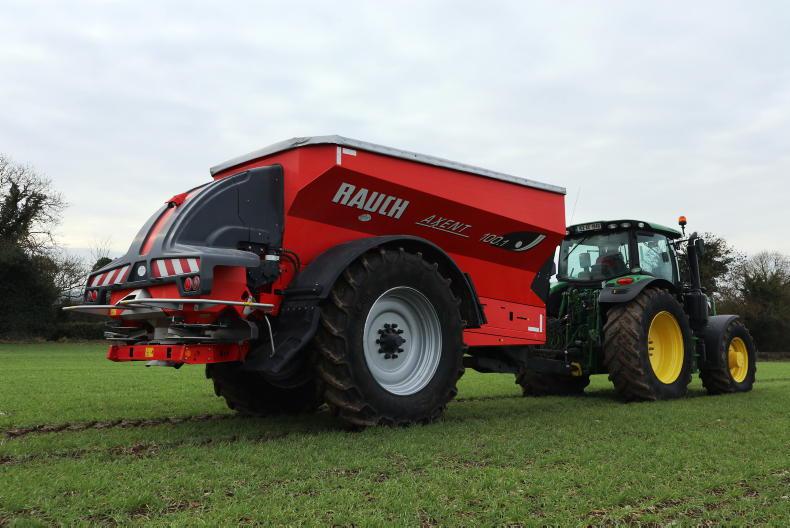
He noted that he would switch the kit in five to 10 minutes by himself. It’s a matter of opening the linkage-type arms, the electric cable and the hydraulic hoses. This five vane retrofit kit will cost an additional €10,000 plus VAT.
Output
The move to the trailed spreader has naturally increased the amount of ground Graham can cover in a shorter period of time.
He explained: “Depending on the rate and the ground in question, I can easily spread 60t/day, allowing me to get across around 400 acres a day. I could probably do that with the last machine but I would be working half the night.”
With consistently unpredictable weather, tillage farmers have to be able to react quickly to changing conditions and cover large areas as efficiently and quickly as possible.
Efficiency is important to Graham as he looks after both the spraying and spreading duties himself.
The list price for the 10t spreader comes in at €110,000 plus VAT. However, there is a large variation in price depending on the spec required.
The reference cost for a trailed fertiliser spreader with full GPS control at the time was €67,500, excluding the VAT.
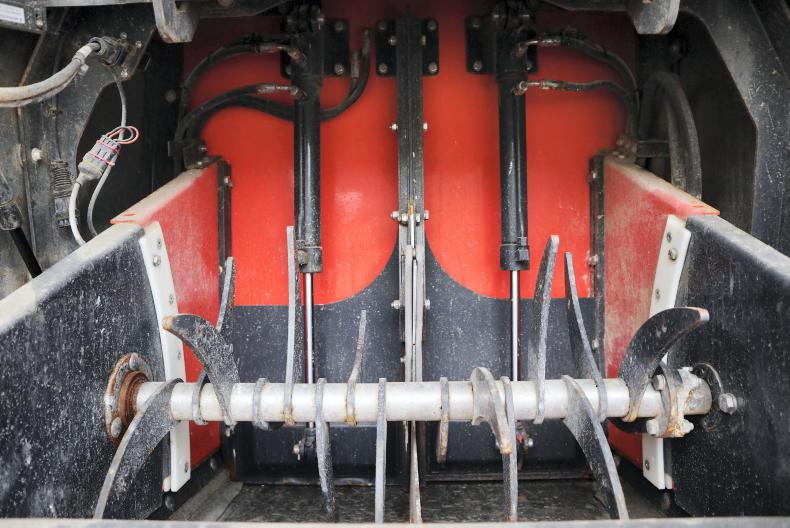
The flow from the hopper into each of the two pre-chambers is controlled independently from two doors. Beyond the door is a comb type auger.
At the time of purchase (2019), the maximum grant aid that Graham was eligible for was 40% of the €67,500, which equated to €27,000 in grant aid.
Verdict
Now with two seasons of spreading under his wing with the Axent, Graham is happy overall with the spreader’s performance.
He explained: “Over the course of the first season the spreader ran perfectly. I tray-tested every day I spread and I was really happy with its performance.
“The second season started off very good but then it began to struggle to spread evenly which was disappointing.
“We switched from S6 to S8 vanes which are a bit longer and we’ve had no issues with spread accuracy since.
“I use the mobile phone app for inputting the different compounds and parameters and I find it very accurate.
“We never have to make much adjustments to the spreader, but when we do, we can immediately see the results which is very important”.
“We got some small issues with the control box but Kuhn Centre Ireland sorted this out. Overall, I’m really happy with it.
“With the exception of a broken grid due to a lump of fertiliser which was my own fault, I’ve had no running costs to date.
“Although I drive it myself, I would have no issue putting someone else driving it, as once the technology is set up, there is very little thinking required or to go wrong”.
Likes
Consistent spread pattern.On-board hydraulics are a gift.Huge output capacity.Dislikes
Cost of the steering axle.Control system can be a little tricky to get used to.Specs:
Model: Axent 100.1.Spreading width (fertiliser): 18m to 50m.Empty weight: 4,250kg (without spreading module- 350kg).Overall width: 2.55m.Overall height/filling height: 3.15 m/2.90m. Tyres: 520/85 R42. List price: €95,000 plus VAT including lime pack.
Since its introduction, many farmers have availed of the Tillage Capital Investment Scheme (TCIS) to help fund machinery and technology upgrades, including Graham Sixsmith from Kilmeague, Co Kildare. Two years ago, Graham updated his 4t mounted Bogballe spreader to a trailed Rauch Axent 100.1, 10t fertiliser spreader with GPS section control.
Why Rauch?
In 2007, Graham bought a 4t spreader mounted on a bogey axle. This spreader was later upgraded in 2013. The system was working successfully.
However, as the acreage being farmed and the distance being travelled began to grow, so too did the workload. The system meant that Graham and his father needed to travel up to 24 miles each way with two tractors on the spreader and fertiliser trailer. It was becoming time- and labour-intensive.
With the backing of a successful TCIS application at his disposal, Graham decided this was the opportunity to upgrade his system. He carefully studied all brands on the market, before narrowing it down to either a Rauch or Amazone machine.

The Axent 100.1 shares the same rear-mounted fertiliser spreading unit as what’s on its mounted spreaders.
Graham explained: “I suppose the reason we didn’t opt for the Amazone machine was that it didn’t have its own on-board hydraulic system like the Rauch.
“Amazone also only offered an 8.5t model at the time, and it was the last of the older models. I also preferred the Rauch headland management system.”
Spreader mechanism
Rauch use the same rear-mounted fertiliser spreading unit on the bulk spreader featured as what’s on its mounted spreaders. The fertiliser is fed from the hopper via a hydraulic belt conveyor into a pre-chamber above the spreader discs.
The flow into each of the two pre-chambers is controlled independently via two doors. Beyond the door, a comb-type auger feeds the fertiliser along.
Two sensors each side determine the rate of fertiliser flow into the pre-chambers, based on the desired application rate set by the operator in the cab. All of the drives on the machine are hydraulic.
The Axent’s rear spreading unit uses Rauch’s own EMC (Electronic Massflow Control) technology. EMC is Rauch’s solution to measuring the flow rate of fertiliser.
The system is based on the principle that the drive torque of each disc is proportional to the flow of fertiliser.
In simple terms, this means the rate of fertiliser leaving the spreading vanes is measured through the torque in the gearbox. Therefore, weigh cells are not necessarily needed but the option is available.
EMC technology controls flow rate on each side of the machine individually.
While spreading, shutter position constantly changes on each side of the spreader independently to achieve the set flow rate, all of which can be monitored from the terminal in the cab. Rauch says the flow rate of the fertiliser is measured every two seconds.

.
Graham opted for the additional weigh cells which allows him to keep an eye on the spreader’s load from the control terminal.
The machine uses its own independent hydraulic system. The PTO-driven axial piston pump provides the power to function the rubber belt drive, pre-dosing slides and the rear spreading unit.
The unit also has its own cooling system, with the viscous fan running as required.
Section control
Graham’s machine is equipped with the larger 12.1in CCI Isobus terminal. He noted that he doesn’t use the tractor’s control terminal as he likes to have one screen dedicated solely to the spreader and GPS function, rather than having to swipe through several pages on a small tractor screen.
The GPS receiver is independently mounted on the spreader, meaning any tractor on the farm can easily pull the spreader.
The spreader is fitted with full GPS section control. It has 30 sections at 1m intervals, which will each automatically switch off to prevent overlapping of fertiliser.
Using a GPS spreader wasn’t new for Graham, but using section control on a fertiliser spreader was.

“When I go into each field, I know exactly how much fertiliser I want to apply. Since I moved to the new spreader that hasn’t changed, but the accuracy of placement probably has.
“With the section control, I know I’m definitely not wasting any fertiliser on the headlands or when I come to gearogs. I have had section control on my sprayer for a few years now.
“At first I didn’t want to use it, but now I couldn’t go away from it.”
Graham works off 30m tramlines. He said the big challenge with wide working widths is the quality of fertiliser.
He added that often times with his previous spreader, achieving the 30m working width was challenging, largely down to fertiliser quality issues.
For this reason, Graham has moved away from conventional blended fertiliser and moved towards CCF compounds.
The hydraulic front suspension through the two rams allows Graham to change the angle of spread if he gets a bad batch of fertiliser. He also noted it provides for very smooth transport.
The wider working width also means less wheel damage to both the field and the crops. To date, he hasn’t moved to variable rate application.
One big benefit Graham noted is the ability to set the system at a headland mode.
This means the two discs can be set to different rotation speeds to spread at two different widths and application rates for more precise placement.
Fert, lime or litter
The Axent fertiliser spreader can also be equipped with the Lime PowerPack as an optional extra. This has been developed for applying lime and dry organic fertilisers.
Graham decided to spec this to his machine when purchasing, thus eliminating the need for separate lime and fertiliser spreaders on the farm.
Despite not using it to apply lime just yet, Graham has plans to cover 100 acres of ground with lime this spring.
However, he did use the kit last year to spread upwards of 300 tonnes of poultry manure.
He noted that the spreader applied the 84% DM manure to a 10m working width, while it spread poultry manure pellets up to 24m.
He was also very impressed with how easy it was to switch spreading kits.

He noted that he would switch the kit in five to 10 minutes by himself. It’s a matter of opening the linkage-type arms, the electric cable and the hydraulic hoses. This five vane retrofit kit will cost an additional €10,000 plus VAT.
Output
The move to the trailed spreader has naturally increased the amount of ground Graham can cover in a shorter period of time.
He explained: “Depending on the rate and the ground in question, I can easily spread 60t/day, allowing me to get across around 400 acres a day. I could probably do that with the last machine but I would be working half the night.”
With consistently unpredictable weather, tillage farmers have to be able to react quickly to changing conditions and cover large areas as efficiently and quickly as possible.
Efficiency is important to Graham as he looks after both the spraying and spreading duties himself.
The list price for the 10t spreader comes in at €110,000 plus VAT. However, there is a large variation in price depending on the spec required.
The reference cost for a trailed fertiliser spreader with full GPS control at the time was €67,500, excluding the VAT.

The flow from the hopper into each of the two pre-chambers is controlled independently from two doors. Beyond the door is a comb type auger.
At the time of purchase (2019), the maximum grant aid that Graham was eligible for was 40% of the €67,500, which equated to €27,000 in grant aid.
Verdict
Now with two seasons of spreading under his wing with the Axent, Graham is happy overall with the spreader’s performance.
He explained: “Over the course of the first season the spreader ran perfectly. I tray-tested every day I spread and I was really happy with its performance.
“The second season started off very good but then it began to struggle to spread evenly which was disappointing.
“We switched from S6 to S8 vanes which are a bit longer and we’ve had no issues with spread accuracy since.
“I use the mobile phone app for inputting the different compounds and parameters and I find it very accurate.
“We never have to make much adjustments to the spreader, but when we do, we can immediately see the results which is very important”.
“We got some small issues with the control box but Kuhn Centre Ireland sorted this out. Overall, I’m really happy with it.
“With the exception of a broken grid due to a lump of fertiliser which was my own fault, I’ve had no running costs to date.
“Although I drive it myself, I would have no issue putting someone else driving it, as once the technology is set up, there is very little thinking required or to go wrong”.
Likes
Consistent spread pattern.On-board hydraulics are a gift.Huge output capacity.Dislikes
Cost of the steering axle.Control system can be a little tricky to get used to.Specs:
Model: Axent 100.1.Spreading width (fertiliser): 18m to 50m.Empty weight: 4,250kg (without spreading module- 350kg).Overall width: 2.55m.Overall height/filling height: 3.15 m/2.90m. Tyres: 520/85 R42. List price: €95,000 plus VAT including lime pack. 







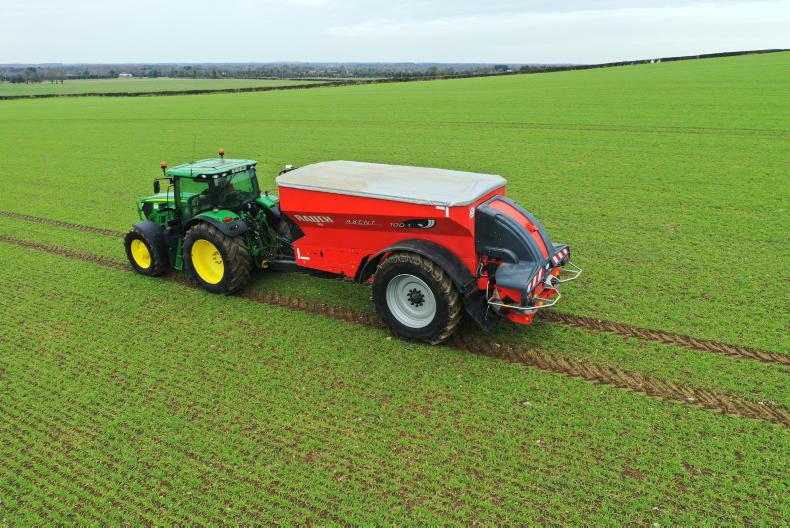

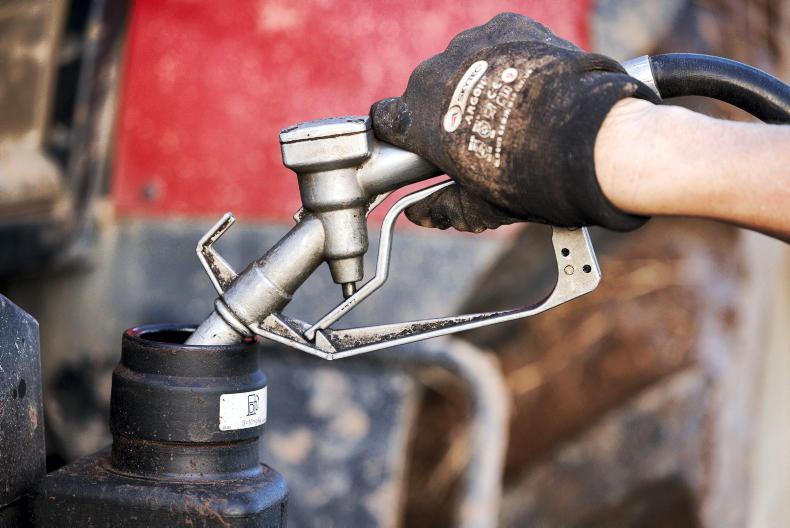


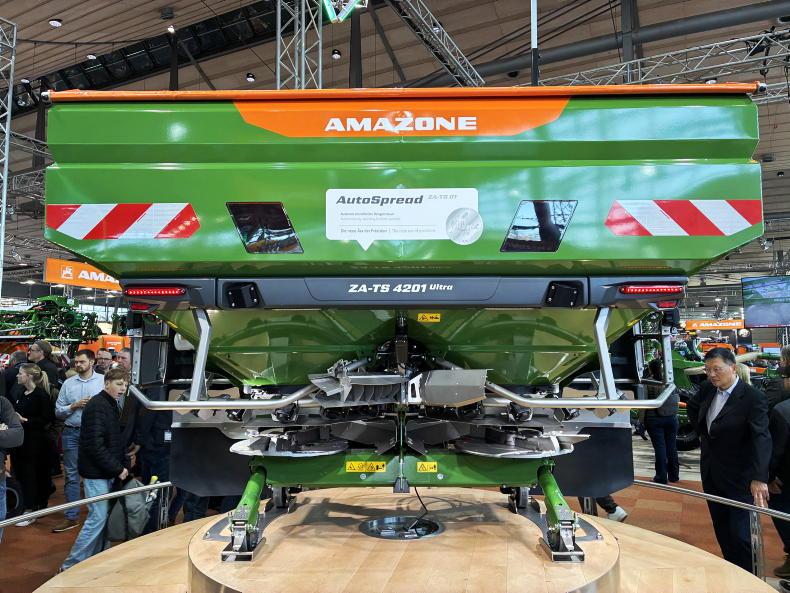

SHARING OPTIONS